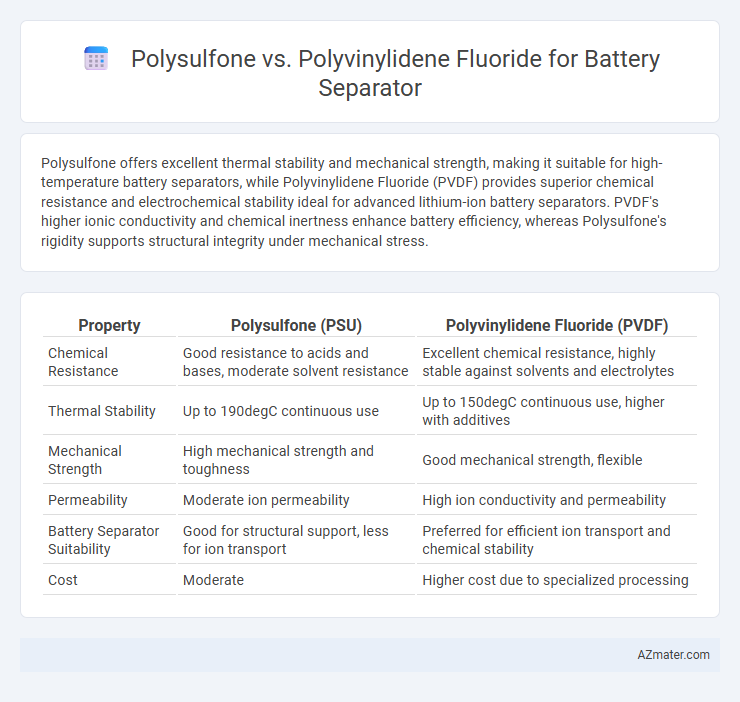Polysulfone offers excellent thermal stability and mechanical strength, making it suitable for high-temperature battery separators, while Polyvinylidene Fluoride (PVDF) provides superior chemical resistance and electrochemical stability ideal for advanced lithium-ion battery separators. PVDF's higher ionic conductivity and chemical inertness enhance battery efficiency, whereas Polysulfone's rigidity supports structural integrity under mechanical stress.
Table of Comparison
| Property | Polysulfone (PSU) | Polyvinylidene Fluoride (PVDF) |
|---|---|---|
| Chemical Resistance | Good resistance to acids and bases, moderate solvent resistance | Excellent chemical resistance, highly stable against solvents and electrolytes |
| Thermal Stability | Up to 190degC continuous use | Up to 150degC continuous use, higher with additives |
| Mechanical Strength | High mechanical strength and toughness | Good mechanical strength, flexible |
| Permeability | Moderate ion permeability | High ion conductivity and permeability |
| Battery Separator Suitability | Good for structural support, less for ion transport | Preferred for efficient ion transport and chemical stability |
| Cost | Moderate | Higher cost due to specialized processing |
Introduction to Battery Separator Materials
Battery separators are essential components in lithium-ion batteries, preventing physical contact between the anode and cathode while allowing ionic conductivity. Polysulfone offers high thermal stability and mechanical strength, making it suitable for demanding battery environments. Polyvinylidene fluoride (PVDF) provides excellent chemical resistance and flexibility, enhancing electrolyte compatibility and overall battery performance.
Overview of Polysulfone (PSU)
Polysulfone (PSU) is a high-performance thermoplastic known for its excellent thermal stability, chemical resistance, and mechanical strength, making it a strong candidate for battery separator applications. Its glass transition temperature typically ranges around 185degC, enabling PSU separators to maintain dimensional integrity under high-temperature operating conditions. Moreover, PSU's intrinsic resistance to oxidative degradation enhances battery safety by preventing separator failure in aggressive electrochemical environments.
Overview of Polyvinylidene Fluoride (PVDF)
Polyvinylidene fluoride (PVDF) is a highly non-reactive and pure thermoplastic fluoropolymer used extensively as a battery separator due to its excellent chemical resistance and thermal stability up to 150degC. Its superior electrochemical stability and high dielectric constant enable efficient ion conduction while preventing short circuits in lithium-ion batteries. PVDF's mechanical strength and resistance to oxidation make it a preferred choice over polysulfone in enhancing battery safety and longevity.
Chemical Properties Comparison
Polysulfone (PSU) and Polyvinylidene Fluoride (PVDF) differ significantly in chemical stability and solvent resistance, with PSU exhibiting strong thermal stability up to 190-200degC and excellent resistance to hydrolysis, making it suitable for high-temperature battery separators. PVDF offers superior chemical resistance to acids, bases, and organic solvents and has a lower melting point around 170degC, which provides flexibility but limits high-temperature applications. The choice between PSU and PVDF for battery separators hinges on balancing PSU's robust thermal endurance and PVDF's chemical inertness to optimize battery performance and durability.
Mechanical Strength and Durability
Polysulfone exhibits excellent mechanical strength and thermal stability, making it highly durable under battery operating conditions, while polyvinylidene fluoride offers superior chemical resistance and flexibility but generally lower mechanical robustness. Battery separators made from polysulfone demonstrate enhanced tensile strength and resistance to deformation, critical for maintaining structural integrity during charge-discharge cycles. Polyvinylidene fluoride separators provide good durability against chemical degradation but may experience faster mechanical wear compared to polysulfone counterparts in high-stress environments.
Electrochemical Stability in Battery Applications
Polysulfone exhibits commendable thermal stability and mechanical strength but shows limited electrochemical stability in aggressive battery electrolytes compared to polyvinylidene fluoride (PVDF), which offers superior chemical resistance and maintains structural integrity under diverse electrochemical conditions. PVDF's high oxidation potential and excellent compatibility with lithium-ion battery chemistries make it a preferred separator material for long-term cycling performance and safety. The electrochemical stability window of PVDF typically exceeds 5 V versus Li/Li+, outperforming polysulfone and thereby enhancing battery lifespan and efficiency.
Thermal Stability and Safety
Polysulfone (PSF) and Polyvinylidene Fluoride (PVDF) are prominent materials for battery separators, with PVDF exhibiting superior thermal stability due to its high melting point around 170-175degC and excellent chemical resistance, making it ideal for high-temperature battery applications. Polysulfone offers good mechanical strength and moderate thermal stability with a glass transition temperature near 185degC but can undergo thermal degradation under prolonged exposure to elevated temperatures. For safety, PVDF's strong electrolyte compatibility and higher thermal shutdown capability enhance battery performance and reduce risks of thermal runaway, whereas polysulfone separators may require additional modifications to meet stringent safety standards in advanced lithium-ion batteries.
Ion Conductivity and Separator Performance
Polysulfone exhibits moderate ion conductivity and excellent thermal stability, making it suitable for battery separators that require high mechanical strength and chemical resistance. Polyvinylidene fluoride (PVDF) offers superior ion conductivity due to its high polarity and porosity, enhancing electrolyte uptake and ionic transport in lithium-ion batteries. The choice between Polysulfone and PVDF depends on balancing separator performance metrics such as thermal stability, chemical resistance, and ion conductivity to optimize overall battery efficiency and safety.
Cost and Manufacturability Considerations
Polysulfone offers cost advantages due to its lower raw material price compared to Polyvinylidene Fluoride (PVDF), making it a more economical choice for battery separator production. The thermoplastic nature of polysulfone allows for easier processing with conventional fabrication methods like injection molding and extrusion, enhancing manufacturability. PVDF's higher chemical resistance and electrochemical stability come at the cost of more complex solvent casting and higher material expenses, which can increase overall battery separator manufacturing costs.
Application Suitability: Polysulfone vs PVDF
Polysulfone exhibits excellent thermal stability and mechanical strength, making it suitable for battery separators operating in high-temperature environments and demanding mechanical stress conditions. Polyvinylidene fluoride (PVDF) offers superior chemical resistance and electrochemical stability, ideal for lithium-ion batteries requiring enhanced ionic conductivity and long cycle life. The choice between polysulfone and PVDF depends on specific battery requirements, with polysulfone favored for structural durability and PVDF preferred for electrolyte compatibility and performance.

Infographic: Polysulfone vs Polyvinylidene Fluoride for Battery Separator
 azmater.com
azmater.com